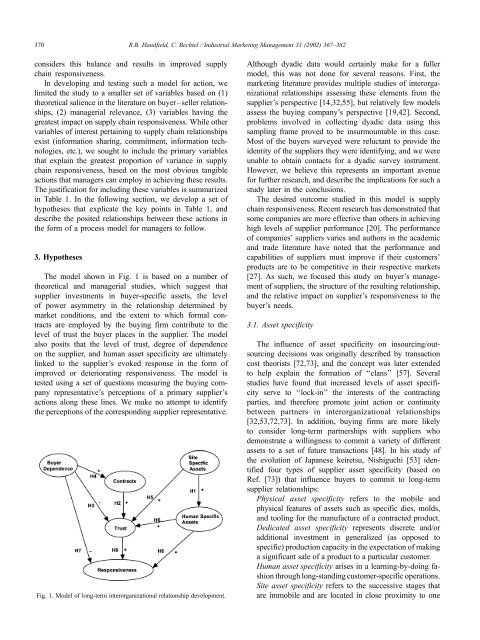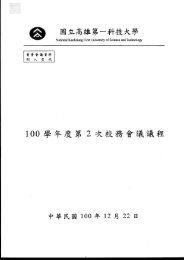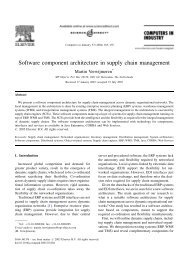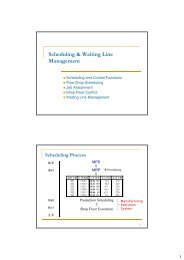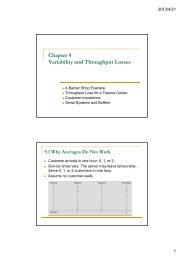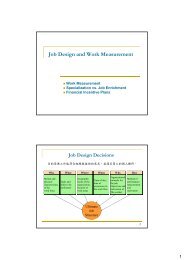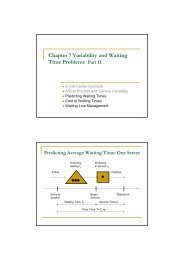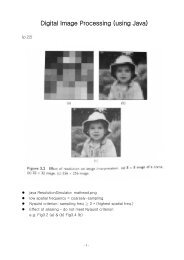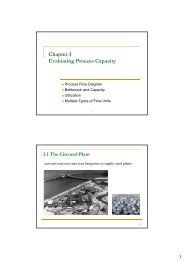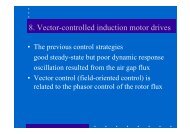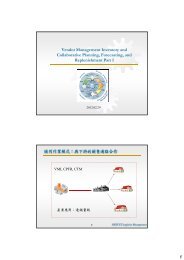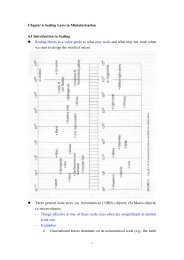370R.B. H<strong>and</strong>field, C. Bechtel / Industrial Market<strong>in</strong>g Management 31 (2002) 367–382considers this balance <strong>and</strong> results <strong>in</strong> improved <strong>supply</strong>cha<strong>in</strong> responsiveness.In develop<strong>in</strong>g <strong>and</strong> test<strong>in</strong>g such a model for action, welimited the study to a smaller set <strong>of</strong> variables based on (1)theoretical salience <strong>in</strong> the literature on buyer–seller <strong>relationship</strong>s,(2) managerial relevance, (3) variables hav<strong>in</strong>g thegreatest impact on <strong>supply</strong> cha<strong>in</strong> responsiveness. While othervariables <strong>of</strong> <strong>in</strong>terest perta<strong>in</strong><strong>in</strong>g to <strong>supply</strong> cha<strong>in</strong> <strong>relationship</strong>sexist (<strong>in</strong>formation shar<strong>in</strong>g, commitment, <strong>in</strong>formation technologies,etc.), we sought to <strong>in</strong>clude the primary variablesthat expla<strong>in</strong> the greatest proportion <strong>of</strong> variance <strong>in</strong> <strong>supply</strong>cha<strong>in</strong> responsiveness, based on the most obvious tangibleactions that managers can employ <strong>in</strong> achiev<strong>in</strong>g these results.<strong>The</strong> justification for <strong>in</strong>clud<strong>in</strong>g these variables is summarized<strong>in</strong> Table 1. In the follow<strong>in</strong>g section, we develop a set <strong>of</strong>hypotheses that explicate the key po<strong>in</strong>ts <strong>in</strong> Table 1, <strong>and</strong>describe the posited <strong>relationship</strong>s between these actions <strong>in</strong>the form <strong>of</strong> a process model for managers to follow.3. Hypotheses<strong>The</strong> model shown <strong>in</strong> Fig. 1 is based on a number <strong>of</strong>theoretical <strong>and</strong> managerial studies, which suggest thatsupplier <strong>in</strong>vestments <strong>in</strong> buyer-specific assets, the level<strong>of</strong> power asymmetry <strong>in</strong> the <strong>relationship</strong> determ<strong>in</strong>ed bymarket conditions, <strong>and</strong> the extent to which formal contractsare employed by the buy<strong>in</strong>g firm contribute to thelevel <strong>of</strong> <strong>trust</strong> the buyer places <strong>in</strong> the supplier. <strong>The</strong> modelalso posits that the level <strong>of</strong> <strong>trust</strong>, degree <strong>of</strong> dependenceon the supplier, <strong>and</strong> human asset specificity are ultimatelyl<strong>in</strong>ked to the supplier’s evoked response <strong>in</strong> the form <strong>of</strong>improved or deteriorat<strong>in</strong>g responsiveness. <strong>The</strong> model istested us<strong>in</strong>g a set <strong>of</strong> questions measur<strong>in</strong>g the buy<strong>in</strong>g companyrepresentative’s perceptions <strong>of</strong> a primary supplier’sactions along these l<strong>in</strong>es. We make no attempt to identifythe perceptions <strong>of</strong> the correspond<strong>in</strong>g supplier representative.Fig. 1. Model <strong>of</strong> long-term <strong>in</strong>terorganizational <strong>relationship</strong> development.Although dyadic data would certa<strong>in</strong>ly make for a fullermodel, this was not done for several reasons. First, themarket<strong>in</strong>g literature provides multiple studies <strong>of</strong> <strong>in</strong>terorganizational<strong>relationship</strong>s assess<strong>in</strong>g these elements from thesupplier’s perspective [14,32,55], but relatively few modelsassess the buy<strong>in</strong>g company’s perspective [19,42]. Second,problems <strong>in</strong>volved <strong>in</strong> collect<strong>in</strong>g dyadic data us<strong>in</strong>g thissampl<strong>in</strong>g frame proved to be <strong>in</strong>surmountable <strong>in</strong> this case.Most <strong>of</strong> the buyers surveyed were reluctant to provide theidentity <strong>of</strong> the suppliers they were identify<strong>in</strong>g, <strong>and</strong> we wereunable to obta<strong>in</strong> contacts for a dyadic survey <strong>in</strong>strument.However, we believe this represents an important avenuefor further research, <strong>and</strong> describe the implications for such astudy later <strong>in</strong> the conclusions.<strong>The</strong> desired outcome studied <strong>in</strong> this model is <strong>supply</strong>cha<strong>in</strong> responsiveness. Recent research has demonstrated thatsome companies are more effective than others <strong>in</strong> achiev<strong>in</strong>ghigh levels <strong>of</strong> supplier performance [20]. <strong>The</strong> performance<strong>of</strong> companies’ suppliers varies <strong>and</strong> authors <strong>in</strong> the academic<strong>and</strong> trade literature have noted that the performance <strong>and</strong>capabilities <strong>of</strong> suppliers must improve if their customers’products are to be competitive <strong>in</strong> their respective markets[27]. As such, we focused this study on buyer’s management<strong>of</strong> suppliers, the <strong>structure</strong> <strong>of</strong> the result<strong>in</strong>g <strong>relationship</strong>,<strong>and</strong> the relative impact on supplier’s responsiveness to thebuyer’s needs.3.1. Asset specificity<strong>The</strong> <strong>in</strong>fluence <strong>of</strong> asset specificity on <strong>in</strong>sourc<strong>in</strong>g/outsourc<strong>in</strong>gdecisions was orig<strong>in</strong>ally described by transactioncost theorists [72,73], <strong>and</strong> the concept was later extendedto help expla<strong>in</strong> the formation <strong>of</strong> ‘‘clans’’ [57]. Severalstudies have found that <strong>in</strong>creased levels <strong>of</strong> asset specificityserve to ‘‘lock-<strong>in</strong>’’ the <strong>in</strong>terests <strong>of</strong> the contract<strong>in</strong>gparties, <strong>and</strong> therefore promote jo<strong>in</strong>t action or cont<strong>in</strong>uitybetween partners <strong>in</strong> <strong>in</strong>terorganizational <strong>relationship</strong>s[32,53,72,73]. In addition, buy<strong>in</strong>g firms are more likelyto consider long-term partnerships with suppliers whodemonstrate a will<strong>in</strong>gness to commit a variety <strong>of</strong> differentassets to a set <strong>of</strong> future transactions [48]. In his study <strong>of</strong>the evolution <strong>of</strong> Japanese keiretsu, Nishiguchi [53] identifiedfour types <strong>of</strong> supplier asset specificity (based onRef. [73]) that <strong>in</strong>fluence buyers to commit to long-termsupplier <strong>relationship</strong>s:Physical asset specificity refers to the mobile <strong>and</strong>physical features <strong>of</strong> assets such as specific dies, molds,<strong>and</strong> tool<strong>in</strong>g for the manufacture <strong>of</strong> a contracted product.Dedicated asset specificity represents discrete <strong>and</strong>/oradditional <strong>in</strong>vestment <strong>in</strong> generalized (as opposed tospecific) production capacity <strong>in</strong> the expectation <strong>of</strong> mak<strong>in</strong>ga significant sale <strong>of</strong> a product to a particular customer.Human asset specificity arises <strong>in</strong> a learn<strong>in</strong>g-by-do<strong>in</strong>g fashionthrough long-st<strong>and</strong><strong>in</strong>g customer-specific operations.Site asset specificity refers to the successive stages thatare immobile <strong>and</strong> are located <strong>in</strong> close proximity to one
R.B. H<strong>and</strong>field, C. Bechtel / Industrial Market<strong>in</strong>g Management 31 (2002) 367–382 371another so as to economize on <strong>in</strong>ventory <strong>and</strong> transportationexpenses.Of these forms <strong>of</strong> asset specificity, we are most <strong>in</strong>terested<strong>in</strong> site assets <strong>and</strong> human assets. Moreover, physical assetsare typically a function <strong>of</strong> the nature <strong>of</strong> the product (i.e.,whether it requires tool<strong>in</strong>g, etc.) <strong>and</strong> may not dist<strong>in</strong>guish arelational form. Dedicated asset specificity is a form <strong>of</strong><strong>in</strong>vestment that is limited <strong>in</strong> use <strong>in</strong> North America. Someautomotive <strong>and</strong> electronics companies have begun to requiresupplies to build facilities or exp<strong>and</strong> near their facilities, butfor the most part this has not become a st<strong>and</strong>ard requirementfor do<strong>in</strong>g bus<strong>in</strong>ess [27].Supplier <strong>in</strong>vestments <strong>in</strong> human- <strong>and</strong> site-specificassets, however, are <strong>in</strong>creas<strong>in</strong>gly becom<strong>in</strong>g requirementsfor suppliers who wish to conduct bus<strong>in</strong>ess <strong>in</strong> global<strong>supply</strong> cha<strong>in</strong>s [27,30]. Dedicated customer <strong>in</strong>vestmentsrepresent a requirement that buy<strong>in</strong>g company managersmay choose to apply as a means to <strong>structure</strong> a supplier<strong>relationship</strong>. Further, dedicated <strong>and</strong> human supplier<strong>in</strong>vestments are <strong>in</strong>creas<strong>in</strong>gly studied <strong>in</strong> both the management<strong>and</strong> market<strong>in</strong>g literature [9,12,16,17,19,67]. <strong>The</strong>sesupplier <strong>in</strong>vestments may <strong>in</strong>clude people with specialskills or highly specialized mach<strong>in</strong>es that are specific toa particular customer. Such <strong>in</strong>vestments are nontransferable,<strong>and</strong> the benefits <strong>of</strong> the <strong>in</strong>vestment are unrecoverablefor the <strong>supply</strong><strong>in</strong>g firm if the <strong>relationship</strong> is prematurelydissolved [9]. When applied properly, supplier-based<strong>in</strong>vestments permit tighter <strong>in</strong>tegration, improved communication<strong>and</strong> alignment between <strong>supply</strong> cha<strong>in</strong> partners[27,28].In contrast<strong>in</strong>g successful <strong>and</strong> unsuccessful partnershipagreements, Nishiguchi [53] found that successful partnershipshad greater levels <strong>of</strong> site asset specificity <strong>and</strong> threetimes as much human asset specificity as their less successfulcounterparts. Dyer [15] also found that successfulpartnerships <strong>in</strong>vested substantially more <strong>in</strong> site, dedicated,<strong>and</strong> human asset specificity. Dyer also suggested that site<strong>and</strong> dedicated asset specificity leads to <strong>in</strong>vestments <strong>in</strong>customer-specific human assets. Specifically, the most successfulautomotive firms dur<strong>in</strong>g the years 1982–1991 hadsuppliers who <strong>in</strong>vested <strong>in</strong> site-specific assets that providedproximity to their plants. This proximity helped facilitatehuman-specific assets <strong>in</strong> the form <strong>of</strong> greater <strong>in</strong>formation <strong>and</strong>personnel exchange, lead<strong>in</strong>g eventually to superior firmperformance <strong>and</strong> responsive suppliers. Other recent work<strong>in</strong> the area <strong>of</strong> ‘‘customer <strong>relationship</strong> management’’ <strong>and</strong>personal market<strong>in</strong>g approaches supports the logic that oncefirms make the f<strong>in</strong>ancial commitment to support<strong>in</strong>g acustomer, they follow with dedicated account representatives<strong>and</strong> eng<strong>in</strong>eers who work closely (<strong>and</strong> are sometimescolocated) at the customer’s location [48,64,67]. We thereforepropose that:Hypothesis 1: Suppliers <strong>in</strong>vest<strong>in</strong>g <strong>in</strong> greater perceivedsite-specific assets are more likely to <strong>in</strong>vest <strong>in</strong> greaterlevels <strong>of</strong> perceived human-specific assets.3.2. ContractsContracts are legal <strong>in</strong>struments that explicitly def<strong>in</strong>e theterms <strong>of</strong> <strong>in</strong>terorganizational agreements. R<strong>in</strong>g <strong>and</strong> Van deVen [63] have concluded that even when ‘‘a high level <strong>of</strong><strong>trust</strong> is present <strong>in</strong> a <strong>relationship</strong>, a reliance on <strong>trust</strong> at the<strong>in</strong>terpersonal level may be conditioned by legal systems ororganizational <strong>role</strong> responsibilities, mitigat<strong>in</strong>g the ability <strong>of</strong>the parties to rely on <strong>trust</strong> as a matter <strong>of</strong> first preference.’’<strong>The</strong>y have likened this situation to two people <strong>in</strong> a boat, whonevertheless wear life jackets despite the implicit knowledgethat the other party would jump <strong>in</strong> <strong>and</strong> attempt to save theother if he were to fall overboard. This suggests an <strong>in</strong>terest<strong>in</strong>gparadox: Although long-term <strong>in</strong>terorganizational <strong>relationship</strong>smay be based on <strong>trust</strong>, the existence <strong>of</strong> preventativeformal contracts may help to ensure the buyer that <strong>trust</strong> <strong>in</strong> thesupplier is well-founded (<strong>and</strong> vice versa). R<strong>in</strong>g <strong>and</strong> Van deVen [63] took this argument a step further by develop<strong>in</strong>g anevolutionary model suggest<strong>in</strong>g that formal contracts lead togreater levels <strong>of</strong> <strong>trust</strong>, which over time, lead to <strong>in</strong>formalpsychological contracts between buyers <strong>and</strong> suppliers.When <strong>trust</strong> is limited between the parties, contractualagreements are commonly established to enhance their legalobligations. <strong>The</strong>se can range from limited s<strong>in</strong>gle functionagreements, to very specific <strong>and</strong> broad-based contractualagreements that cover complete bus<strong>in</strong>ess operational activities,such as franchise contracts [70]. We argue that suchcontractual safeguards are important <strong>in</strong> determ<strong>in</strong><strong>in</strong>g thelevel <strong>of</strong> <strong>trust</strong> the buyer has <strong>in</strong> the supplier, <strong>in</strong> that they helpdef<strong>in</strong>e the nature <strong>of</strong> the <strong>relationship</strong> between the partnersfrom the outset.Hypothesis 2: <strong>The</strong> presence <strong>of</strong> detailed signed contractswill <strong>in</strong>crease the buyer’s perceived level <strong>of</strong> <strong>trust</strong> <strong>in</strong>the supplier.3.3. Perceived buyer-dependence on supplier<strong>The</strong> perception <strong>of</strong> dependence is an important dimension<strong>of</strong> buyer–seller <strong>relationship</strong>s. Dependence exists when oneparty does not entirely control all <strong>of</strong> the conditions necessaryfor achievement <strong>of</strong> an action or a desired outcomeperformed by the other party. Resource-dependence theory[22,58] specifies conditions under which one social unit isable to obta<strong>in</strong> compliance with its dem<strong>and</strong>s when dependencebetween the parties is present. Three critical factorsthat affect the degree <strong>of</strong> perceived dependence <strong>in</strong>clude theimportance <strong>of</strong> the resource, the extent to which the <strong>in</strong>terestgroup has discretion over it, <strong>and</strong> the extent to which thereare limited alternatives [58]. In this context, we refer to<strong>in</strong>creased buyer-dependence as a situation when there arefew suppliers <strong>of</strong> an important commodity with<strong>in</strong> a localmarket, or the supplier is the only party capable <strong>of</strong> provid<strong>in</strong>gthe product or service.In such situations, the supplier can potentially exploittheir market power, <strong>and</strong> buyers will have fewer opportun-


